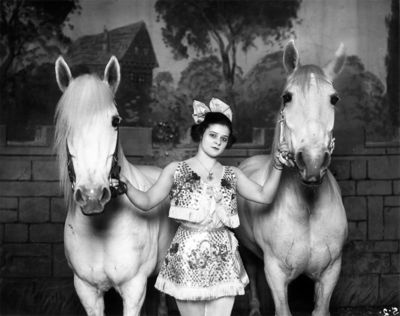Difference between revisions of "Main Page"
From Circopedia
| Line 15: | Line 15: | ||
==In The Spotlight== | ==In The Spotlight== | ||
| − | === | + | ===THE CIRCUSES OF MOSCOW=== |
[[File:May_Wirth_1920.jpeg|right|400px]] | [[File:May_Wirth_1920.jpeg|right|400px]] | ||
| − | + | Although the name Moscow Circus is familiar to the public all over the world, there has never been one specific “Moscow Circus” whose troupe toured internationally. The name was a generic term for the circus shows from the USSR traveling abroad during the Soviet Era. It has, over time, become synonymous with “Russian circus.” Yet, there are today (2017) two resident circuses in Moscow, Circus Nikulin on Tsvetnoy Boulevard, and the Bolshoi Circus (bolshoi means big, in Russian) on Vernadsky Avenue—and there have been indeed several others before them. | |
| − | + | The first circus built in Russia was established by the French equestrian Jacques Tourniaire, who settled in 1827 in what was then the Russian capital, St. Petersburg. The building, designed by the architect Smaragd Shustov and named Cirque Olympique, was located near the Fontanka canal, practically where St. Petersburg’s Bolshoi State Circus (the former Circus Ciniselli) stands today. Tourniaire’s circus had only a short existence: it was bought back by the government of St. Petersburg in 1828 to be transformed into a theater. Still, the event didn’t fail to catch the attention of the Muscovites, who always took exception to the influence of Peter The Great’s Baltic capital. | |
| − | + | The previous year, Tourniaire had exhibited his equestrian prowess in Moscow, in the manège of the Pashkov mansion (today the Russian State Library), on Mokhovaya Street. Another famous trick rider, Jacob Bates, had long preceded him in the former Russian capital, where he performed in 1864, and since then, Moscow had welcomed several equestrian companies—among which that of Pierre Mayheu, the famous Spanish rider, in 1790—but contrary to most European major cities, the great Russian metropolis didn’t have a permanent circus of its own.... ([[The Circuses Of Moscow|more...]]) | |
==New Biographies== | ==New Biographies== | ||
Revision as of 20:59, 14 August 2017
|
In The Spotlight
THE CIRCUSES OF MOSCOW
Although the name Moscow Circus is familiar to the public all over the world, there has never been one specific “Moscow Circus” whose troupe toured internationally. The name was a generic term for the circus shows from the USSR traveling abroad during the Soviet Era. It has, over time, become synonymous with “Russian circus.” Yet, there are today (2017) two resident circuses in Moscow, Circus Nikulin on Tsvetnoy Boulevard, and the Bolshoi Circus (bolshoi means big, in Russian) on Vernadsky Avenue—and there have been indeed several others before them.
The first circus built in Russia was established by the French equestrian Jacques Tourniaire, who settled in 1827 in what was then the Russian capital, St. Petersburg. The building, designed by the architect Smaragd Shustov and named Cirque Olympique, was located near the Fontanka canal, practically where St. Petersburg’s Bolshoi State Circus (the former Circus Ciniselli) stands today. Tourniaire’s circus had only a short existence: it was bought back by the government of St. Petersburg in 1828 to be transformed into a theater. Still, the event didn’t fail to catch the attention of the Muscovites, who always took exception to the influence of Peter The Great’s Baltic capital.
The previous year, Tourniaire had exhibited his equestrian prowess in Moscow, in the manège of the Pashkov mansion (today the Russian State Library), on Mokhovaya Street. Another famous trickAny specific exercise in a circus act. rider, Jacob Bates, had long preceded him in the former Russian capital, where he performed in 1864, and since then, Moscow had welcomed several equestrian companies—among which that of Pierre Mayheu, the famous Spanish rider, in 1790—but contrary to most European major cities, the great Russian metropolis didn’t have a permanent circus of its own.... (more...)
New Biographies
- Norman Crider, Juggler
- Zhejiang Acrobatic Troupe, Chinese Acrobatics
- Gene Mendez, High Wire Artist
- Franz Czeisler (Tihany), Magician, Circus Owner
- Circuses Fernando and Medrano, History
New Videos
- Kyle Driggs, Juggler (2014)
- Tanja & Frieda, Double Trapeze (1994)
- Michael Ferreri, Juggler (2014)
- Aime Morales, Cyr Wheel (2014)
- Émilien Bouglione, Horses at Liberty (1963)
Featured Oral Histories
- Anastasia Dementieva-Kornilova – Vadim Vernik Interview (2017)
- Les Frères Knie, Documentary (1962)
- Jean Richard and Jean-Pierre Richard at the Cirque Jean Richard – Christian Boner Interview (1979)
- Jérôme Medrano about Buster Keaton at the Cirque Medrano (1947)
- Moira Orfei, Circus Owner – Davide Maggio Interview (2012)
A Message from the Editor
CIRCOPEDIA is a constantly evolving and expanding archive of the international circus. New videos, biographies, essays, and documents are added to the site on a weekly—and sometimes daily—basis. Keep visiting us: even if today you don't find what you're looking for, it may well be here tomorrow! And if you are a serious circus scholar and spot a factual or historical inaccuracy, do not hesitate to contact us: we will definitely consider your remarks and suggestions.
- Dominique Jando
- Founder and Curator
